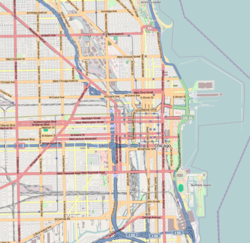Second Presbyterian Church (Chicago)
|
Second Presbyterian Church
|
|

(2010)
|
|
|
Location in central Chicago
|
|
| Location | 1936 South Michigan Avenue Chicago, Illinois |
|---|---|
| Coordinates | 41°51′21″N 87°37′28″W / 41.85583°N 87.62444°WCoordinates: 41°51′21″N 87°37′28″W / 41.85583°N 87.62444°W |
| Built | 1874 |
| Architect | Renwick & Sands; Shaw, Howard Van Doren |
| Architectural style | Late Gothic Revival, Other |
| NRHP Reference # | 74000754 |
| Significant dates | |
| Added to NRHP | December 27, 1974 |
| Designated NHL | February 27, 2013 |
| Designated CL | September 28, 1977 |
Second Presbyterian Church is a landmark Gothic Revival church located on South Michigan Avenue in Chicago, Illinois, United States. In the late nineteenth and early twentieth centuries, some of Chicago’s most prominent families attended this church. It is renowned for its interior, completely redone in the Arts and Crafts style after a disastrous fire in 1900. The sanctuary is one of America’s best examples of an unaltered Arts and Crafts church interior, fully embodying that movement’s principles of simplicity, hand craftsmanship, and unity of design. It also boasts nine imposing Tiffany windows. The church was listed on the National Register of Historic Places in 1974 and later designated a Chicago Landmark on September 28, 1977. It was designated a National Historic Landmark in March 2013.
Second Presbyterian Church organized in 1842 as an offshoot of the city’s first Presbyterian congregation, which had formed in 1833. From 1851 until 1871, the congregation worshipped in a church at the northeast corner of Wabash Avenue and Washington Street in downtown Chicago. Known as the spotted church because of the tar deposits in its limestone blocks, this building was designed by the noted eastern architect, James Renwick, Jr. Renwick later designed St. Patrick's Cathedral in New York City and the original building of the Smithsonian Institution. Already in the late 1860s, downtown Chicago was becoming more commercial and less residential, and Second Presbyterian’s leaders prepared plans to follow its membership to the near South Side. Just a few weeks before the Great Chicago Fire in October 1871, which destroyed the spotted church, the congregation had merged with another congregation and had relocated to the South Side.
...
Wikipedia

